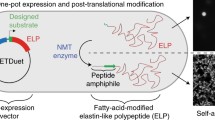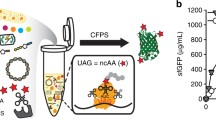Abstract
Based on the central dogma of protein synthesis, traditional methods for protein engineering require that altering protein structure and function must be accompanied by changing the nucleotide sequence of the genes encoding the protein. However, the preparation of a template gene for each individual protein requires a great deal of time and effort, thereby limiting the throughput and scope of studying engineered proteins. In this study, we describe translation-level engineering of proteins using cell-free protein synthesis. Taking advantage of the promiscuity of aminoacyl tRNA synthetases in accepting structurally similar amino acid analogues, unnatural amino acids were introduced into elastin-like polypeptides in place of the corresponding cognate amino acids. Through the incorporation of various analogues and starting from the same gene, the phase transition temperatures of elastin-like polypeptides became tunable. Our results demonstrate the usefulness of cell-free protein synthesis for protein engineering using unnatural amino acids without the need for cloning.
Similar content being viewed by others
References
Annabi, N., S. M. Mithieux, G. Camci-Unal, M. R. Dokmecia, A. S. Weiss, and A. Khademhosseini (2013) Elastomeric recombinant protein-based biomaterials. Biochem. Eng. J. 77: 110–118.
MacEwan, S. R. and A. Chilkoti (2010) Elastin-like polypeptides: Biomedical applications of tunable biopolymers. Biopolymers. 94: 60–77.
Lee, C. H., A. Singla, and Y. Lee (2001) Biomedical applications of collagen. Int. J. Pharm. 221: 1–22.
Kundu, B., N. E. Kurland, B. Subia, C. Patra, F. B. Engel, V. K. Yadavalli, and S. C. Kundu (2014) Silk proteins for biomedical applications: Bioengineering perspectives. Prog. Polym. Sci. 39: 251–267.
Rouse, J. G. and M. E. Dyke (2010) A review of keratin-based biomaterials for biomedical applications. Materials. 3: 999–1014.
Choi, B. H., H. Cheong, Y. K. Jo, S. Y. Bahn, J. H. Seo, and H. J. Cha (2014) Highly purified mussel adhesive protein to secure biosafety fro in vivo applications. Microb. Cell. Fact. 13: 52.
Rodriguez-Cabello, J. C., S. Prieto, J. Reguera, F. J. Arias, and A. Ribeiro (2007) Biofunctional design of elastin-like polmers for advanced applications in nanobiotechnology. J. Biomateri. Sci. Polym. Edn. 18: 269–286.
Serrono, V., W. Liu, and S. Franzen (2007) An infrared spectroscopic study of the conformational transition of elastin-like polypeptides. Biophys. J. 93: 2429–2435.
Hassouneh, W., T. Christenesen, and A. Chilkoti (2010) Elastinlike polypeptides as a purification tag for recombinant proteins. Curr. Protoc. Protein. Sci. 6.11.1-.6.11.16.
Kostal, J., A. Mulchandani, and E. Chen (2001) Tunable biopolymers for heavy metal removal. Macromol. 34: 2257–2261.
Lei Cai., Cong, B. Dinh, and Saran, C. Heilshorn (2014) One-pot synthesis of elastin-like polypeptide hydrogels with grafted VEGF-mimetic peptides. Biomater. Sci. 2: 757–765.
Urry, D. W., C. H. Luan, T. M. Parker, D. C. Gowda, K. U. Prasad, M. C. Reid, and A. Safavy (1991) Temperature of polypeptide inverse temperature transition depends on mean residue hydrophobicity. J. Amer. Chem. Soc. 113: 4346–4348.
Park, J. E. and J. I. Won (2009) Thermal behaviours of elastinlike polypeptides (ELPs) according to their physical properties and environmental conditions. Biotechnol. Bioproc. Eng. 14: 662–667.
McMillan, R. A., T. A. T. Lee, and V. P. Conticello (1999) Rapid assembly of synthetic genes encoding protein polymers. Macromol. 32: 3643–3648.
Meyer, D. E. and A. Chilkoti (2002) Genetically encoded synthesis of protein-based polymers with precisely specified molecular weight and sequence by recursive directional ligation: Examples from the elastin-like polypeptide system. Biomacromol. 3: 357–367.
Won, J. I. and A. E. Barron (2002) A new cloning method for the preparation of long repetitive polypeptides without a sequence requirement. Macromol. 35: 8281–8287.
Hartman, M. C. T., K. Josephson, C. W. Lin, and J. K. Szostak (2007) An expanded set of amino acid analogs for the ribosomal translation of unnatural peptides. PLoS ONE. 2: e972.
Hartman, M. C., J. W. Josephson, and J. W. Szostak (2008) Enzymatic aminoacylation of tRNA with unnatural amino acids. Proc. Natl. Acad. Sci. 103: 4356–4361.
Kim, W., R. A. McMillan, J. P. Snyder, and V. P. Conticello (2005) A stereoelectronic effect on turn formation due to proline substitution in elastin-mimetic polypeptides. J. Am. Chem. Soc. 127: 18121–18132.
Kim, W, Y., A. George, M. Evans, and V. P. Conticello (2004) Cotranslational incorporation of a structurally diverse series of proline analogues in an Escherichia coli expression system. ChemBioChem. 5: 928–936.
Kim, T. W., J. E. Keum, I. S. Oh, C. Y. Choi, C. G. Park, and D. M. Kim (2006) Simple procedures for the construction of a robust and cost-effective cell-free protein synthesis system. J. Biotechnol. 126: 554–561.
Chu, H. S., J. E. Park, D. M. Kim, B. G. Kim, B. G, and J. I. Won (2010) The effects of supplementing specific amino acids on the expression of elastin-like polypeptides. Protein Exp. Purif. 74: 298–303.
Edwardraja, S., S. Sriram, R. Govindan, N. Budisa, and S. G. Lee (2011) Enhancing the thermal stability of a single-chain Fv fragment by in vivo global fluorination of the proline residues. Mol. BioSyst. 7: 258–265.
Son, J. M., J. H. Ahn, M. Y. Hwang, C. G. Park, C. Y. Choi, and D. M. Kim (2006) Enhancing the efficiency of cell-free protein synthesis through the polymerase-chain-reaction-based addition of a translation enhancer sequence and the in situ removal of the extra amino acids residues. Anal. Biochem. 351: 187–192.
Hong, S. H., I. Ntai, A. D. Haimovich, N. L. Kelleher, F. J. Isaacs, and M. C. Jewett (2014) Cell-free protein synthesis from a release factor 1 deficient Escherichia coli activates efficient and multiple site-specific nonstandard amino acid incorporation. ACS Synth. Biol. 3: 398–409.
Gubbens, J., S. J. Kim, Z. Y. Yang, A. E. Johnson, and W. R. Skach (2010) In vitro incorporation on nonnatural amino acids into protein using tRNA(Cys)-derived opal, ochre, and amber suppressor tRNAs. RNA. 16: 1660–1672.
Oh. S. J., K. H. Lee, H. C. Kim, C. Catherine, H. Yun, and D. M. Kim (2014) Translational incorporation of multiple unnatural amino acids in a cell-free protein synthesis system. Biotechnol. Bioproc. Eng. 19: 426–432.
Author information
Authors and Affiliations
Corresponding author
Rights and permissions
About this article
Cite this article
Catherine, C., Oh, S.J., Lee, KH. et al. Engineering thermal properties of elastin-like polypeptides by incorporation of unnatural amino acids in a cell-free protein synthesis system. Biotechnol Bioproc E 20, 417–422 (2015). https://doi.org/10.1007/s12257-015-0190-1
Received:
Revised:
Accepted:
Published:
Issue Date:
DOI: https://doi.org/10.1007/s12257-015-0190-1




